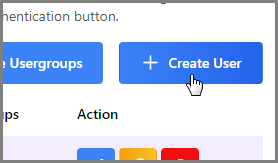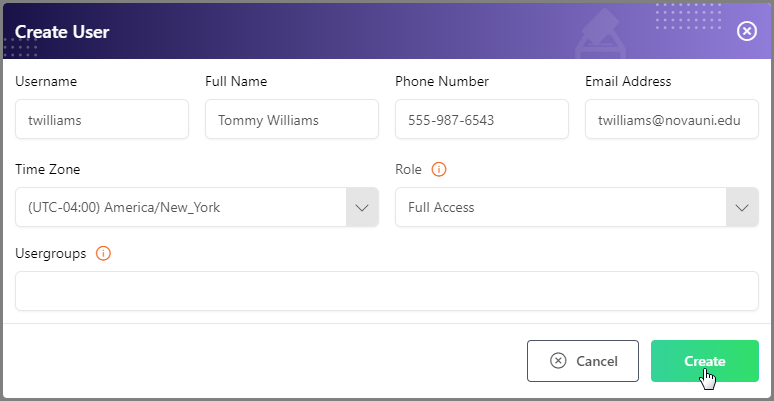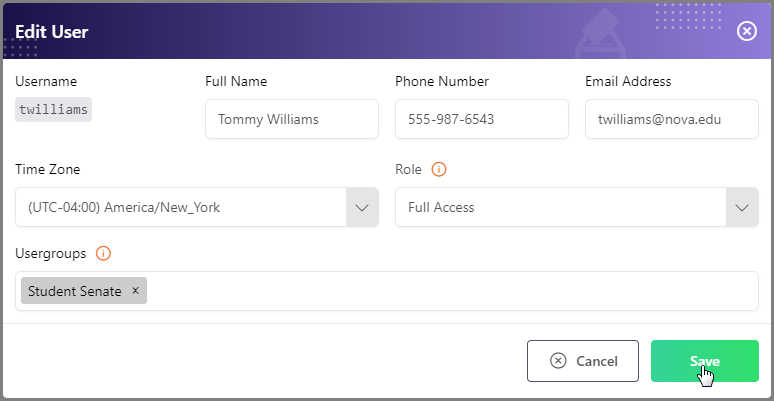Creating Users
To create a new user, click on the blue Create User button on the Users page.

In the pop-up window that appears, specify a username, the user's full name, their phone number, their email address, their time zone, and their role.
There are four predefined user roles you may choose from, or may create a custom role:
with Super User, the user can access the entire Election Manager tool as well as create and manage other users. Super users cannot be restricted by usergroup, have full access to all sections in an election, may manage account-wide Settings, and may access the Billing section that contains historical invoices.
with Full Access, the user can navigate to and access all sections and, in sections where functions can be performed (such as changing or adding data), they are allowed to perform all allowed functions.
with Read Only Access, the user can navigate to and access all sections, but they cannot change or add any new data to these sections.
with No Access, the user cannot navigate to nor access any section.
with Custom, the user can navigate and access, as well as perform functions within, the sections you specify.

Once you have filled out the Create User form, click Create. Upon successful creation of a user, you will receive a green Success Message. An email from Simply Voting will be sent to the user's specified email address containing password activation instructions. Instruct your users to keep an eye out for their activation email.

Are multiple users necessary?
Organizations have varying needs when it comes to user access to the Election Manager tool.
For instance, your organization may have the need for an external auditor to keep track of turnout during the election and independently tabulate the results at the close of the election. To address this need, you could create a user for this auditor and give them permission access to the Electors, Reports, Results, and Election Log sections.
Other organizations may simply employ Super users, foregoing other user roles, if all such individuals have essentially the same responsibilities, duties, access rights, and roles.
And still other organizations may only require one individual to manage their account and elections.
How your organization sets up or configures users is entirely your own choice.
Formatting Usernames
Your organization may choose anything for a user's username, though you should opt for something that is memorable.
If you also plan on creating additional users to support your organization's election management, it may be prudent to decide on a consistent format, though one isn't strictly necessary.
For example, maybe all users, including yourself, will have firstname.lastname as a format. Or perhaps you and all your users have organizational email addresses that could be used as a format. Or perhaps usernames could instead be based on an individual's position or election duties, like cro for chief returning officer or auditor for an election auditor, etc.
In the end, as long as whatever you end up choosing is memorable and makes sense for your organization and its use case, that is all that matters!
Note that the only non-alphanumeric characters that are allowed in usernames are:
underscore: _ (e.g. tommy_williams)
period: . (e.g. tommy.williams)
hyphen: - (e.g. tommy-williams)
at: @ (e.g. twilliams@example.com)
Sharing User Logins
Ensuring that no users are sharing a single username is best practice.
This helps keep your overall account safe, and also enhances the Voting System's ability to provide an audit log (both in the Account Log or in individual Election Logs) of a given user's interaction with your account and your elections. To keep things transparent and auditable, ensure that multiple users each have their own username and password.
Editing Users
Note: The Account Log section within Settings retains records related to user management.
In the user listing located at the bottom of the Users page, for the user you wish to manage, click on their Edit button beneath the Action column to manage their details and permissions. You may also Filter and Search if necessary in order to locate a user.
Other Actions are also possible from the main user listing. You may also:
Delete a user thereby destroying their individual user account.
Send password reset instructions via email to an individual user
Disable two-factor authentication (if enabled) if a user no longer has access to their two-factor device.

On the Edit User page, you can update their user information as well as configure their user role or custom permissions.
